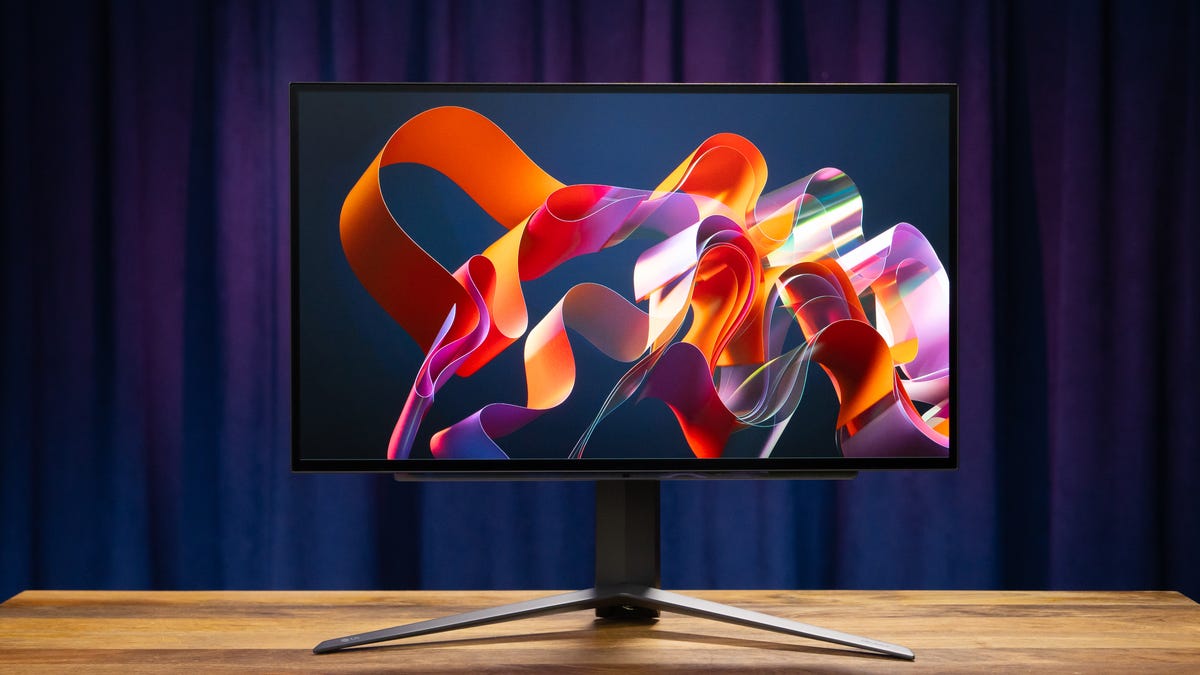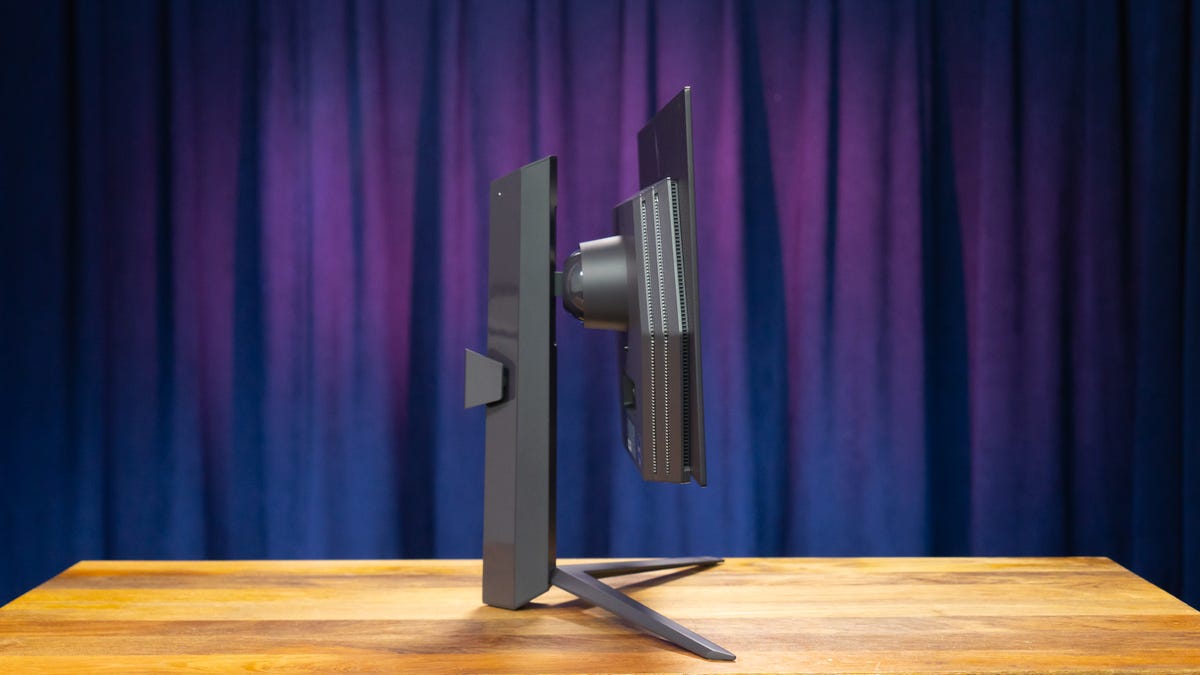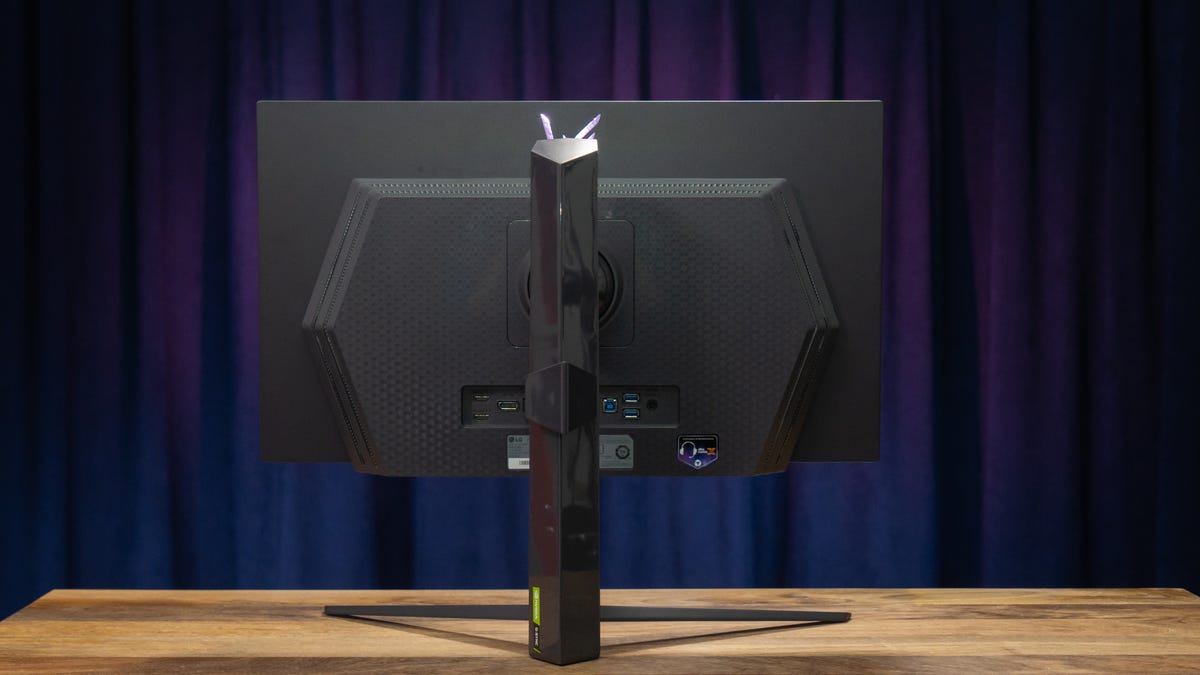Technologies
LG UltraGear OLED 27 Gaming Monitor Review: Part Beauty, Part Beast
HDR, OLED’s naturally high contrast and a 240Hz refresh rate can make games look beautiful, but this monitor’s brightness behavior may make other tasks beastly.

LG’s UltraGear gaming monitors are some of the most popular models you can buy, so the $1,000, 240Hz 27-inch UltraGear 27GR95QE-B OLED HDR model sounded like one of the most interesting monitors to launch at CES this year. And it’s certainly interesting. OLED screens have the highest contrast you can find in a display thanks to their true blacks, and their naturally wide color gamut makes them excellent for TV screens.
But because monitors are used for so many different types of tasks, OLED’s strengths can occasionally become weaknesses and some of the technology’s inherent weaknesses, like brightness, need to be finessed. LG succeeds at gaming, for the most part, but doesn’t entirely succeed at all the other things the monitor needs to do when you’re not playing. There are some things that competing technologies like Quantum Dot OLED, found in monitors such as the Alienware 34 QD-OLED models, handle a bit better.
The UltraGear OLED 27 has a curved 45-inch sibling, the $1,700 45GR95QE-B. It has similar specs to the 27-inch model, with some similar complaints, but its low resolution for its size (3,440×1,440 pixels) means it’s not great for a lot of general uses despite its productivity-friendly dimensions.
Like
- Well constructed with good physical layout
- A ton of features
Don’t Like
- Some people don’t like the antiglare screen
- Can only access all the settings with the remote control
- Brightness performance issues
Design and features
The monitor’s physical design hits most of my checklist items for a «yay!» Easy to access ports: check. Easily maneuverable cable management: check. Solid build quality: check. A stand that allows the screen to pivot, swivel and adjust the height: check. Its only illumination is stripes wrapping around the electronics section the screen is mounted on, which may be too subtle for some people, but I like it. Plus, it looks like a gaming monitor without looking like every other gaming monitor.


The vents around the electronics section can be lit up.
Lori Grunin/CNETBut I hate that you can only access the full set of menu options via the remote. There are a few (like inputs) that you can get to using the hard-to-manipulate single joystick on the monitor and a few more that you can get to using LG’s OnScreen Control software, but a lot of the nitty gritty stuff — gamma and white balance choices, for example — requires the remote. And being able to maintain a slim profile with the skinny OLED screen means it’s got a huge AC adapter brick.
LG UltraGear OLED 27GR95QE-B
| Price | $1,000 |
|---|---|
| Size (diagonal) | 26.5 in (67cm) |
| Panel and backlight | OLED |
| Flat or curved | Flat |
| Resolution, pixel density | 2,560×1,440 pixels, 111ppi |
| Aspect ratio | 16:9 |
| Maximum gamut | 98.5% P3 |
| Brightness (nits, peak/typical) | 1,000 (HDR)/200 (SDR) |
| HDR | HDR10 |
| Adaptive sync | FreeSync Premium and G-Sync Compatible |
| Max vertical refresh rate | 240Hz (DisplayPort and HDMI) |
| Gray/gray response time (milliseconds) | 0.03ms |
| Connections | 2x HDMI 2.1, 1x DisplayPort 1.4, 2x USB-A (plus USB 3.0 upstream) |
| Audio | 3.5mm, SPDIF out; DTS:X support |
| VESA mountable | Yes, 100×100 mm |
| Panel warranty | 2 years parts and labor |
| Release date | January 2023 |
It has an extensive feature set as well. That includes all the basics for gaming, plus a full-range slider for the Black Stabilizer (a necessity for OLED), LG’s Dynamic Action Sync mode, which reduces latency between the system and the screen, and HDMI 2.1 for use with variable refresh-rate supporting Xbox Series X and S, and PS5.
But it’s got a ton of color and image-adjustment options that you rarely see in a gaming monitor, like 18 steps of manual white balance. The LG Calibration Studio is a full-featured profiling tool, complete with recalibration reminders, a host of predefined target spaces (including CIE RGB, Apple RGB, monochrome and a fully user-definable one) and the ability to save two of the custom profiles as hardware presets.


The ports are not only easily accessible, but they sit on either side of the stand so you don’t have to try to tilt or rotate it to accommodate hand contortions in order to plug something in.
Lori Grunin/CNETThe calibration software can be a bit glitchy, but it’s generally well designed. I’m a big fan of being able to set all the options on a single screen, and it’s pretty straightforward to understand and use. There’s one big thing I miss, though, and that’s the choice of calibrating for a full screen (as with most calibration software) rather than just within a 10% window. In the case of the LG, it’s critically important.
Performance
Basically, in SDR the screen can hit around 200 nits for any screen coverage except full screen. At that point, it seems like it drops to a maximum of around 150 nits. That’s why it seems so dim for most general use — because most of us work on full white screens. The perception of dimness isn’t helped by the excellent antiglare treatment, and a more matte finish makes it seem like it’s lower contrast as well, despite OLED’s effectively infinite contrast. People have complained that they wish the screen was more like the typical glossy TV OLED, which tends to look brighter with more saturated colors, but, well, I loathe glossy screens for the same reasons. I’m used to swimming upstream in life.
But it also screws up calibration, because LG’s software (and presumably its factory) calibrates over an area that has different brightness characteristics than full screen, which screws up the gamma calculations. You may not have any problems with gamma oddities and a lot of profile definitions (like sRGB) are based around low peak brightness, partly because they were defined for a time when monitors tended to peak at 200 or 250 nits. However if you’re, say, doing illustrations on a paper white background, it can mess things up and certainly makes color unpredictable.
SDR Color measurements
| Preset | Gamut (% coverage) | White point | Gamma | Peak brightness | Accuracy (DE2K average/max) |
|---|---|---|---|---|---|
| Gamer 1 (default) | 97% P3 | 7,950K | 2.2 | 205 | 5.3/18.4 |
| Gamer 1 (with manual white balance setting C1) | 97% P3 | 6,450K | 2.2 | 188 | 1.9/3.58 |
| Gamer 2 | n/a | 6,900K | 1.2 | 206 | n/a |
| FPS | n/a | 6,800K | 0.97 | 163 | n/a |
| RTS | n/a | 6,500K | 0.83 | 139 | n/a |
| sRGB | 96% sRGB | 6,150K | 1.6 | 110 | 4.06/8.17 |
| Vivid | 97% P3 | 8,600K | 0.93 | 139 | 14.6/27.13 |
| Custom calibration: Adobe RGB (75% window) | 90% Adobe RGB | 6,400K | 2.2 | 197 | 1.8/4.6 |
| Custom calibration: Adobe RGB (full screen) | 90 % Adobe RGB | 6,400K | 1.2 | 170 (at 95% gray), 144 (white) | 5.7/12.1 |
That’s illustrated by the two Adobe RGB calibrations in the chart: I calibrated the monitor using LG Studio, with its 10% window, then measured the results with fractional and full-screen targets in Calman 2023. You can always use a third-party calibration utility to massage it to work, but those profiles can’t be saved as a monitor preset.
The brightness variability also results in odd results for the gaming presets which are further complicated by the Black Stabilizer settings. (OLED can render pure black, which is a case traditional gamma calculations was never meant to handle, so the ability to boost the brightness in shadow areas is essential for visibility.)
The shape of the gamma curve doesn’t really matter much for gaming; appropriate — rather than accurate — shadow detail, contrast, brightness and color matter a lot more (though game designers might disagree). DAS isn’t a pixel refresh booster (OLED is plenty fast at 1ms or less) or motion blur compensation feature so it really doesn’t affect brightness the way those can. And the 240Hz screen refresh is rock solid.
HDR mode measurements
| Preset | White point | Full screen brightness (nits) | 10% window brightness (nits) |
|---|---|---|---|
| Gamer 1 | 6,350K | 146 | 642 |
| Gamer 2 | 8,100K | 159 | 750 (peak 883 — 938 nits in 2% window) |
| FPS | 8,750K | 145 | 709 |
| RTS | 6,350K | 143 | 661 |
| Vivid | 10,000K | 142 | 663 |
HDR looks great, and unlike a lot of HDR monitors this one lets you adjust settings like brightness and the gaming presets have settings for HDR along with SDR. In HDR it hits the full rated 98.5% P3 gamut coverage.
LG rates the display at a peak brightness of 800-1,000 nits for a 3% window, which it certainly hit. But it requires several seconds to ramp up to peak and can’t sustain it for more than a few. In practice, you’re more likely to see a maximum of about 700-750 nits consistently, which still looks great given the monitor’s price. The full-screen brightness is still low, but you’re far less likely to encounter situations where it matters.
If you can get away with spending $1,000 on a monitor that you’ll love for gaming but probably not so much for work, then the 27-inch LG UltraGear OLED will probably tickle your eyeballs. But if it needs to multitask while it takes up space on your desk, you may need to put a little more thought into the purchase.
Testing
All measurements are performed using Portrait Display’s Calman 2023 software using a Calibrite ColorChecker Display Plus (formerly X-Rite i1Display Pro Plus) and a Murideo Six-G pattern generator for HDR testing where necessary, or the Client3 HDR patterns within Calman, where possible. How extensive our testing is depends on the capabilities of the monitor, the screen and backlight technology used, and the judgment of the reviewer. For a complete description of our testing procedures, see How CNET Tests Monitors.
The best laptops in every category
- Best Laptop for 2023
- Best Windows Laptops
- Best Laptop for College
- Best Laptop for High School Students
- Best Budget Laptop Under $500
- Best Dell Laptops
- Best 15-Inch Work and Gaming Laptops
- Best 2-in-1 Laptop
- Best HP Laptops
- Best Gaming Laptop
- Best Cheap Gaming Laptop Under $1,000
- Best Chromebook: 8 Chromebooks Starting at Under $300
Technologies
This 3-in-1 Charger Is a Must-Have for Travelers, and It Just Hit a Record-Low of $95
Snag it for $45 off and charge your iPhone, AirPods and Apple Watch at the same time.

If you’re a frequent traveler, then you know that outlets are a precious commodity in places like airports and coffee shops. So why waste one on a single device when you can charge up to three at once? Right now, you can grab this seriously sleek Ugreen Magflow three-in-one foldable charger for just $95 at Amazon. That’s a $45 discount and the all-time lowest price we’ve seen. Just don’t wait too long, as this deal could expire at any time.
At just 7.4 ounces, this compact charging station is designed to be taken on the go. But despite its size, it still supports 25-watt MagSafe charging for iPhones, as well as 5-watt wireless charging for AirPods and Apple Watches. The charging stand also tilts up to double as a stand, and it’s equipped with 16 magnets to keep your phone aligned and securely in place. Plus, it’s got built-in protections against overheating, overcharging, short-circuiting and more to prevent damage to your devices.
Why this deal matters
This folding Ugreen charger is great for juicing up your devices on the go, and it’s never been more affordable. Plus, Ugreen makes some of the best MagSafe chargers on the market right now, so don’t miss your chance to grab one at a record-low price.
Technologies
Today’s Wordle Hints, Answer and Help for Jan. 13, #1669
Here are hints and the answer for today’s Wordle for Jan. 13, No. 1,669.

Looking for the most recent Wordle answer? Click here for today’s Wordle hints, as well as our daily answers and hints for The New York Times Mini Crossword, Connections, Connections: Sports Edition and Strands puzzles.
Today’s Wordle puzzle is a little tricky, and it might make you hungry. If you need a new starter word, check out our list of which letters show up the most in English words. If you need hints and the answer, read on.
Read more: New Study Reveals Wordle’s Top 10 Toughest Words of 2025
Today’s Wordle hints
Before we show you today’s Wordle answer, we’ll give you some hints. If you don’t want a spoiler, look away now.
Wordle hint No. 1: Repeats
Today’s Wordle answer has no repeated letters.
Wordle hint No. 2: Vowels
Today’s Wordle answer has two vowels.
Wordle hint No. 3: First letter
Today’s Wordle answer begins with G.
Wordle hint No. 4: Last letter
Today’s Wordle answer ends with O.
Wordle hint No. 5: Meaning
Today’s Wordle answer can refer to a spicy Cajun stew popular in New Orleans.
TODAY’S WORDLE ANSWER
Today’s Wordle answer is GUMBO.
Yesterday’s Wordle answer
Yesterday’s Wordle answer, Jan. 12, No. 1,668 was TRIAL.
Recent Wordle answers
Jan. 8, No. 1,664: BLAST
Jan. 9, No. 1,665: EIGHT
Jan. 10, No. 1,666: MANIC
Jan. 11, No. 1,667: QUARK
Don’t miss any of our unbiased tech content and lab-based reviews. Add CNET as a preferred Google source.
What’s the best Wordle starting word?
Don’t be afraid to use our tip sheet ranking all the letters in the alphabet by frequency of uses. In short, you want starter words that lean heavy on E, A and R, and don’t contain Z, J and Q.
Some solid starter words to try:
ADIEU
TRAIN
CLOSE
STARE
NOISE
Technologies
Today’s NYT Strands Hints, Answers and Help for Jan. 13 #681
Here are hints and answers for the NYT Strands puzzle for Jan. 13, No. 681.

Looking for the most recent Strands answer? Click here for our daily Strands hints, as well as our daily answers and hints for The New York Times Mini Crossword, Wordle, Connections and Connections: Sports Edition puzzles.
It took me a while to figure out the theme for today’s NYT Strands puzzle, but once I did, I thought it was a fun one. Some of the answers are difficult to unscramble, so if you need hints and answers, read on.
I go into depth about the rules for Strands in this story.
If you’re looking for today’s Wordle, Connections and Mini Crossword answers, you can visit CNET’s NYT puzzle hints page.
Read more: NYT Connections Turns 1: These Are the 5 Toughest Puzzles So Far
Hint for today’s Strands puzzle
Today’s Strands theme is: You need to chill
If that doesn’t help you, here’s a clue: Brrrr!
Clue words to unlock in-game hints
Your goal is to find hidden words that fit the puzzle’s theme. If you’re stuck, find any words you can. Every time you find three words of four letters or more, Strands will reveal one of the theme words. These are the words I used to get those hints but any words of four or more letters that you find will work:
- GONE, ABLE, TABLE, FOOD, TEEN, LEAF, GOOF, GOOD, SAFE
Answers for today’s Strands puzzle
These are the answers that tie into the theme. The goal of the puzzle is to find them all, including the spangram, a theme word that reaches from one side of the puzzle to the other. When you have all of them (I originally thought there were always eight but learned that the number can vary), every letter on the board will be used. Here are the nonspangram answers:
- PIZZA, SHERBET, POPSICLES, WAFFLES, VEGETABLES
Today’s Strands spangram
Today’s Strands spangram is FROZENFOOD. To find it, start with the F that is five letters down on the far-right row, and wind backward.
Don’t miss any of our unbiased tech content and lab-based reviews. Add CNET as a preferred Google source.
Toughest Strands puzzles
Here are some of the Strands topics I’ve found to be the toughest.
#1: Dated slang. Maybe you didn’t even use this lingo when it was cool. Toughest word: PHAT.
#2: Thar she blows! I guess marine biologists might ace this one. Toughest word: BALEEN or RIGHT.
#3: Off the hook. Again, it helps to know a lot about sea creatures. Sorry, Charlie. Toughest word: BIGEYE or SKIPJACK.
-

 Technologies3 года ago
Technologies3 года agoTech Companies Need to Be Held Accountable for Security, Experts Say
-

 Technologies3 года ago
Technologies3 года agoBest Handheld Game Console in 2023
-

 Technologies3 года ago
Technologies3 года agoTighten Up Your VR Game With the Best Head Straps for Quest 2
-

 Technologies4 года ago
Technologies4 года agoBlack Friday 2021: The best deals on TVs, headphones, kitchenware, and more
-

 Technologies4 года ago
Technologies4 года agoGoogle to require vaccinations as Silicon Valley rethinks return-to-office policies
-

 Technologies4 года ago
Technologies4 года agoVerum, Wickr and Threema: next generation secured messengers
-

 Technologies4 года ago
Technologies4 года agoOlivia Harlan Dekker for Verum Messenger
-

 Technologies4 года ago
Technologies4 года agoiPhone 13 event: How to watch Apple’s big announcement tomorrow

